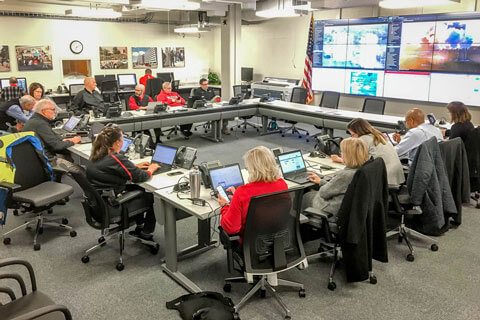Continuity and Recovery

At Illinois State University, ensuring the continuity of essential academic and administrative services during and after significant disruptions is a top priority. Continuity—also referred to as academic continuity, business continuity, continuity of operations, or mission continuity—focuses on maintaining essential services in the wake of a major incident, even if those services are provided at a diminished capacity.
What is Continuity?
Continuity planning addresses scenarios such as:
- Providing meals to residents after a tornado damages a dining facility
- Housing residents after a fire renders a residence hall uninhabitable
- Sustaining research activities when a laboratory becomes unusable
- Delivering courses during extended campus utility outages
- Processing payroll amid significant IT system disruptions
- Staffing a department after a pandemic incident sickens most employees
A Continuity of Operations Plan (COOP) addresses these topics and generally covers a short to mid-term range (roughly 1-30 days). Long-term recovery efforts, such as rebuilding facilities, are addressed in separate recovery plans. This plan is coordinated by the University's emergency management program. For more information, contact Emergency Management.
University Continuity Program
Illinois State University’s Continuity Program is designed to enhance the resilience of the University community. This initiative focuses on ensuring the continued delivery of essential academic, research, administrative other services during times of disruption. By proactively addressing potential risks and challenges, the program aims to protect the university’s mission of academic excellence and service.
The program’s goals include:
- Establishing comprehensive continuity plans tailored to the unique needs of each department.
- Fostering a culture of preparedness and collaboration across the university.
- Mitigating the impacts of emergencies through effective planning and implementation of continuity plans.
- Supporting the seamless recovery and continuation of essential services during and after disruptions.
Coordinated by the Emergency Management department, the program provides resources, training, and planning support to empower departments to develop and refine their continuity strategies. Guided by a cross-divisional Continuity Steering Committee, the initiative encourages active participation from faculty and staff to ensure plans are robust, adaptable, and inclusive of diverse perspectives.
Together, these efforts position Illinois State University to respond effectively to any challenges, safeguarding the institution’s critical functions and supporting the long-term success of its students, faculty, and staff.
The Continuity Steering Team is co-chaired by Amy Hurd, AVP for Undergraduate Education, and Eric Hodges, Director of Emergency Management.
IT Disaster Recovery
A critical component of University Continuity is the restoration of key Information Technology Services. The University’s IT leadership has charged an IT Disaster Recovery Advisory Board to lead the development and testing of a comprehensive IT Disaster Recovery Plan. This plan will identify essential IT services for restoration after major emergencies, including references to procedures to carry out those restorations.
The Advisory Board is chaired by Rachal Roach from Technology Solutions.